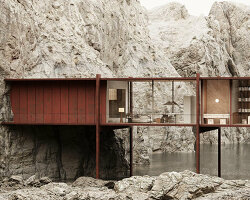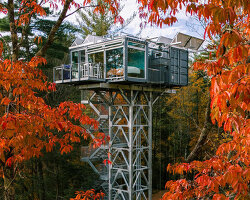
conversation with sustainer homes about zero impact living
all images courtesy of sustainer homes
in the outskirts of amsterdam, there is a courages team made up of creatives, sociologists, architects and technology experts that are working on the future of home livability. the young group at sustainer homes are scared of rising rent, sprawling cities, and unprecedented amounts of energy uncertainty in their lives. so they’ve decided to take it upon themselves to make housing much more affordable, sustainable and flexible than anything offered on the market of today. the team focused on four attributes: energy, air and heating, water collection and disposal, and materials. the result of their developments is a fully independent, self sufficient and comfortable container home with a price point made available to everyone.

the electricity for the home is produced by a combination of solar panels and wind mills to make sure the home has enough energy for regular consumption, year round. a high efficient heat pump combined with high grade insulation makes it warm in the winter and cool in the summer. water is collected from the roof of the container, and filtered for safe drinking. all the used water afterwords is filtered through helophyte filter (a plant based filter), which then is releases back into the ground. sustainer homes decided to have all the materials for construction be reused as well as recyclable. this makes the home ready for this generation of consumers, and the next. the company plans on expand to accommodate hotels, cottages and even emergency housing needs, where local infrastructure systems are difficult to connect to.
 inside interior of the prototype model
inside interior of the prototype model
designboom spoke with the sustainability architect, sol van kempen at sustainer homes to help explain the future of housing developments, and to answer the problematic question: – do people really need to change their habits to be able to live in their self sustaining home?
 solar panels installed on the roof
solar panels installed on the roof
 simply transportation options
simply transportation options
 the team from left to right: sol van kempen (architect), gert van vugt (CEO), niek schoenmakers (interior design), stephanie heckman (community design & marketing), jacintha baas (business development), nick de haas (cleantech & construction advisor), wolf bierens (CTO)
the team from left to right: sol van kempen (architect), gert van vugt (CEO), niek schoenmakers (interior design), stephanie heckman (community design & marketing), jacintha baas (business development), nick de haas (cleantech & construction advisor), wolf bierens (CTO)
 water systems diagram
water systems diagram
 the home combines solar and wind power
the home combines solar and wind power
 capable of being placed anywhere
capable of being placed anywhere
 sustainer homes offer a cottage option
sustainer homes offer a cottage option
 the shipping containers can merge with skyscrapers and urban landscapes
the shipping containers can merge with skyscrapers and urban landscapes
carbon neutrality? (159)
shipping container architecture (197)
PRODUCT LIBRARY
a diverse digital database that acts as a valuable guide in gaining insight and information about a product directly from the manufacturer, and serves as a rich reference point in developing a project or scheme.













